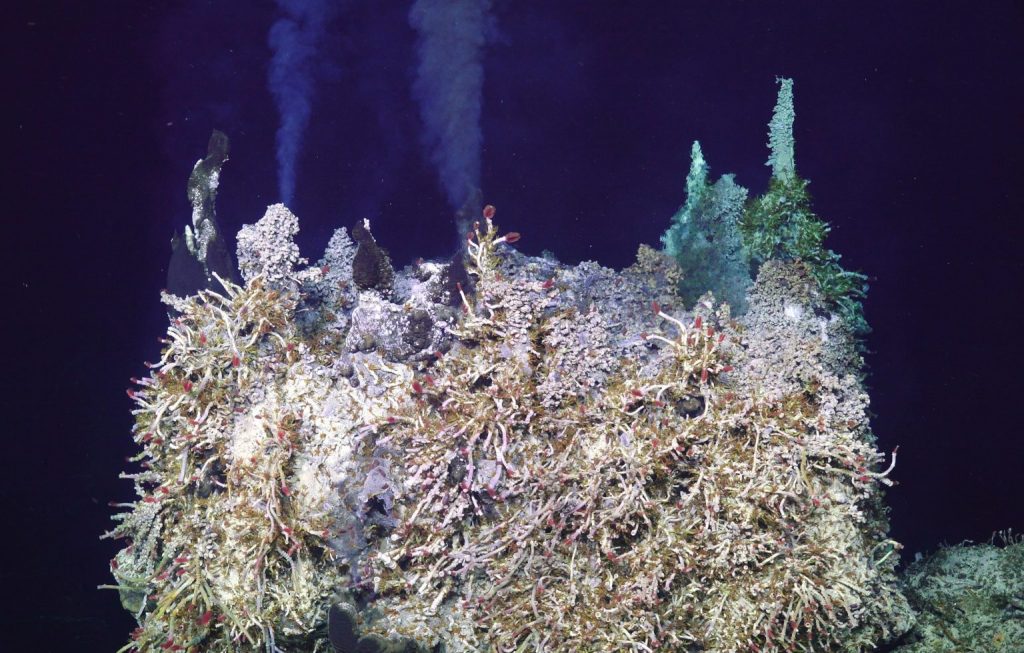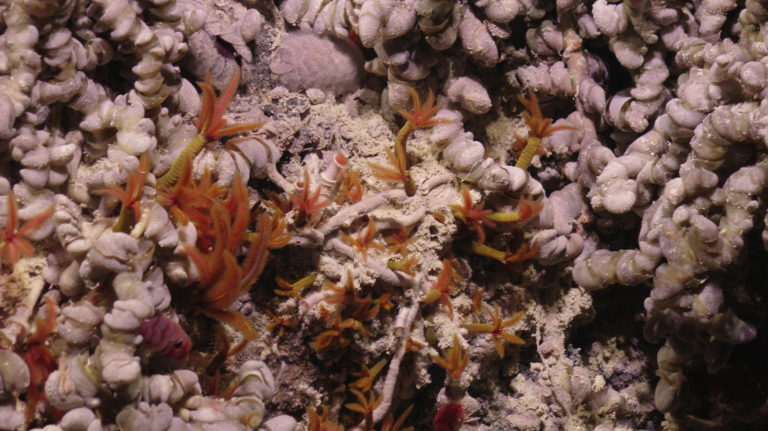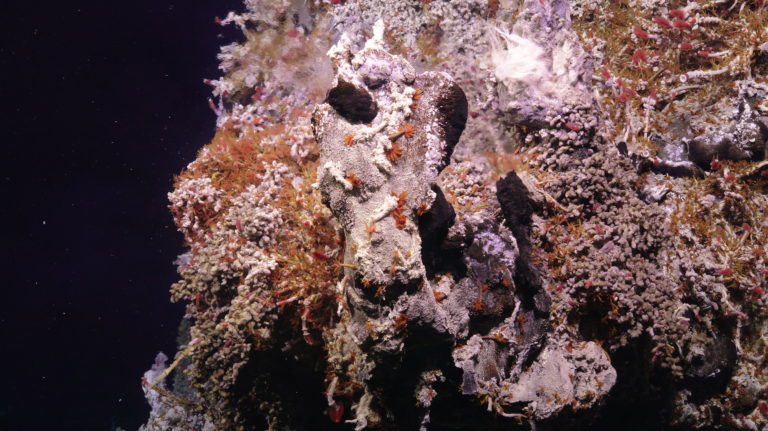On August 8th, we visited the ASHES Hydrothermal Field near the western caldera wall of Axial Seamount. This was the first dive in the caldera of Axial Seamount of VISIONS’25 and a very exciting one for new and old folks alike. Axial Seamount has been under much scrutiny lately due to increased seismic activity and predictions of an upcoming eruption. At the vents, animals live in perpetual darkness, bathed in warm nutrient-rich waters issuing from the porous chimney walls and from cracks in the lava flows, yet surrounded by near freezing seawater. Below are the Leg 1 VISIONS students’ reflections on witnessing this amazing seascape for the first time. It was an honor to be able to share this astounding environment with them.
Megan Gonzalez (Western Washington University): The hydrothermal vents were, without a doubt, the thing I had been most eager to experience. After all, that’s what drew most of us on this trip, to witness the wonders of the Axial Seamount firsthand. Watching the shimmering, superheated water rise through the vents and swirl around the chimneys made every moment of anticipation completely worth it. I’ve seen videos and pictures of vents before, but something about being on the R/V Atlantis and seeing them live made it all the more special.
Isabelle Paulsen (University of Washington): When I first saw the hydrothermal vents at ASHES, reality initially didn’t hit me. When I stepped into the van and the glowing screens were covered in imagery of tube worms, towering vents, and hot fluids spilling out into the deep ocean waters, it didn’t feel like I was there. I have watched live streams of hydrothermal vent expeditions before and been interested in them even before that, so seeing this live video didn’t feel different at first. However, as soon as I came forward and sat down for my shift at the camera monitoring seat, it hit me that those images were not only live but occurring right below us. I felt my heart soar in my chest a bit as we scanned over scale and tube worms, took temperature of 324°C vent fluid, and examined filamentous bacteria-covered equipment. Being up close to the monitors, taking pictures and video of these features I had always dreamed of seeing, but never thought I would during my undergraduate years, was an awe-inspiring experience.
Lacie Levy (University of Washington): It’s hard to describe the difference between seeing videos of hydrothermal vents recorded by others and seeing vents in real time through the lenses of Jason. When it’s just another video it feels like someone else’s adventure and I’m simply hearing the story of it. But being in the control van, being part of the team that makes decisions of where to go and what to look at, that made me feel connected to the environment and gave me a sense of ownership over the science that we are doing here. It’s not just a nature documentary, it’s an environment that I’ve been to and I care about. We still have so much to learn from hydrothermal vents and now I don’t think I’ll ever be able to let go of wanting to study them more.
Anshul Shah (University of Washington): It felt like a different world down there. It was certainly a sight zooming onto the vents, seeing red scale worms and brow orange palm worms, that at a glance looked like plants-then realizing plants can’t possibly survive 2000+ meters down without sunlight. The super-heated fluid seeping out of the ground was entrancing, and it was surprising how close Jason and our instruments could get-very good engineering. All in all, it was a very unique experience seeing such a remote, extreme place on Earth.
Nicole Liew (Queens College): During the dive in ASHES I got to see hydrothermal vents (Mushroom). They were stunning! What surprised me was some of the coloring on it, there were parts that were purple and orange. It was also cool to see the super heated fluids coming out of the chimney in real time. It made it hard to believe that this was forming on the bottom of the ocean. I was really impressed with how close the Jason operators could get to the vents without disturbing them. And when they took the temperature, I saw the side monitor by the sea logging station read it was around 320°C. It’s always a pleasure seeing other sea creatures drift across the screen during dives as well.
Ari Paulik (University of Washington): Pure awe trickled through me as I saw the first bits of vent fluid swirling on the monitor. A whole world centered around this one, relatively small source of life that formed in the middle of a vast area of bareness. The colors of the thriving organisms were vibrant and there was great movement within their small bodies. The fluids streamed out of the vent at a constant rate, appealing to the eye in both movement and the contrast between its dark color and the deep blue water illuminated around it. I was rendered speechless when Jason initially approached Inferno, and it’s moments like those that reassure me I chose my path correctly-this is where I’m supposed to be.

The top of the Inferno Hydrothermal Vent at ASHES. Credit: OOI-RCA/UW/WHOI; J2-1707; V25.

A close up of tubeworms, palm worms, scaleworms, and limpets on Mushroom Hydrothermal Vent. Credit: OOI-RCA/UW/WHOI; J2-1707; V25.

Close up on venting from a spur on the Mushroom Hydrothermal Vent. Credit: UW/NSF-OOI/WHOI; V25.
Recent Updates